tire size CHRYSLER 300 M 2004 1.G Owners Manual
[x] Cancel search | Manufacturer: CHRYSLER, Model Year: 2004, Model line: 300 M, Model: CHRYSLER 300 M 2004 1.GPages: 277, PDF Size: 5.69 MB
Page 163 of 277
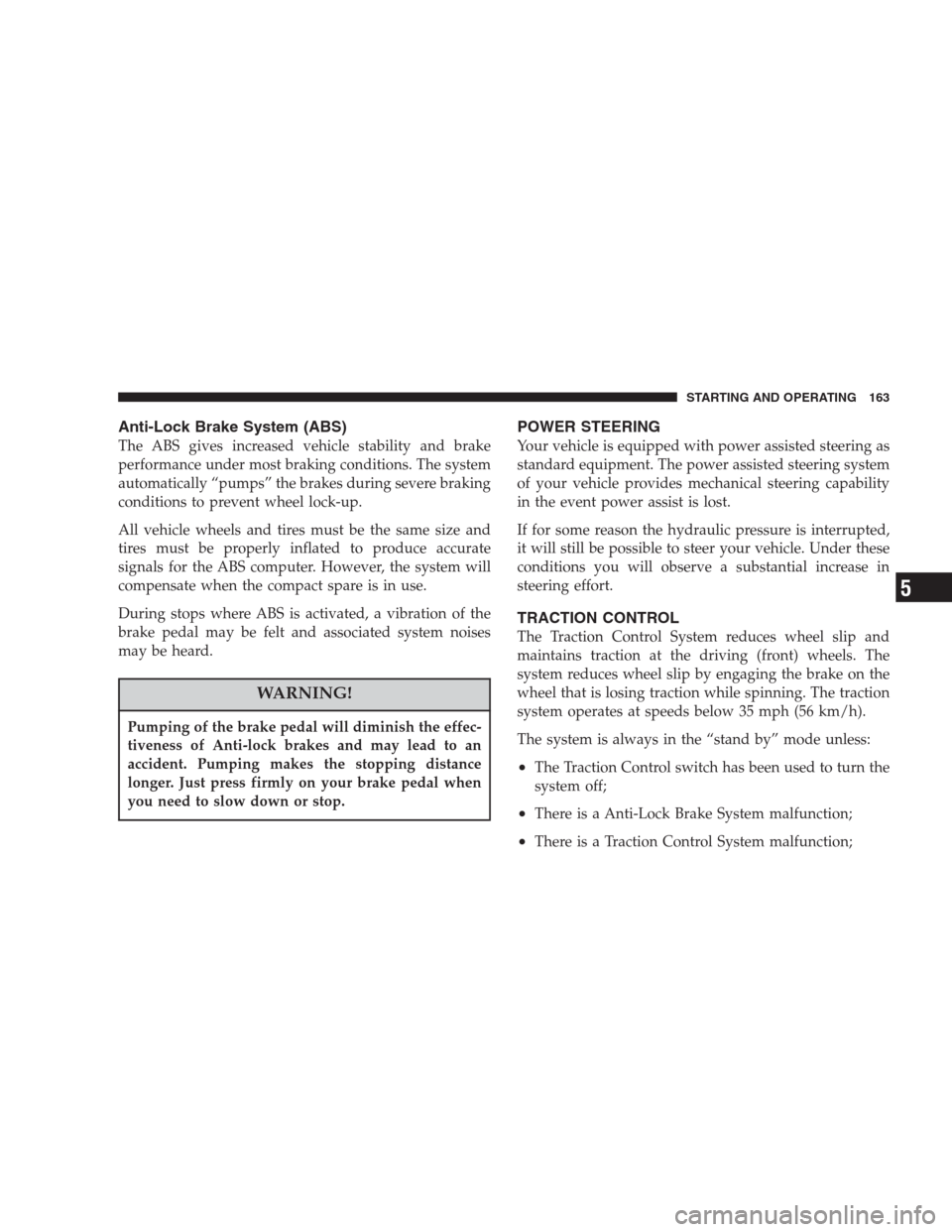
Anti-Lock Brake System (ABS)
The ABS gives increased vehicle stability and brake
performance under most braking conditions. The system
automatically “pumps” the brakes during severe braking
conditions to prevent wheel lock-up.
All vehicle wheels and tires must be the same size and
tires must be properly inflated to produce accurate
signals for the ABS computer. However, the system will
compensate when the compact spare is in use.
During stops where ABS is activated, a vibration of the
brake pedal may be felt and associated system noises
may be heard.
WARNING!
Pumping of the brake pedal will diminish the effec-
tiveness of Anti-lock brakes and may lead to an
accident. Pumping makes the stopping distance
longer. Just press firmly on your brake pedal when
you need to slow down or stop.
POWER STEERING
Your vehicle is equipped with power assisted steering as
standard equipment. The power assisted steering system
of your vehicle provides mechanical steering capability
in the event power assist is lost.
If for some reason the hydraulic pressure is interrupted,
it will still be possible to steer your vehicle. Under these
conditions you will observe a substantial increase in
steering effort.
TRACTION CONTROL
The Traction Control System reduces wheel slip and
maintains traction at the driving (front) wheels. The
system reduces wheel slip by engaging the brake on the
wheel that is losing traction while spinning. The traction
system operates at speeds below 35 mph (56 km/h).
The system is always in the “stand by” mode unless:
•The Traction Control switch has been used to turn the
system off;
•There is a Anti-Lock Brake System malfunction;
•There is a Traction Control System malfunction;
STARTING AND OPERATING 163
5
Page 166 of 277
![CHRYSLER 300 M 2004 1.G Owners Manual period. The cold inflation pressure must not exceed the
maximum values molded into the tire side wall.
Tire pressure may increase from 2 to 6 psi [.13 to.41 bars]
(13 to 40 kPa) during operation. Do N CHRYSLER 300 M 2004 1.G Owners Manual period. The cold inflation pressure must not exceed the
maximum values molded into the tire side wall.
Tire pressure may increase from 2 to 6 psi [.13 to.41 bars]
(13 to 40 kPa) during operation. Do N](/img/25/8462/w960_8462-165.png)
period. The cold inflation pressure must not exceed the
maximum values molded into the tire side wall.
Tire pressure may increase from 2 to 6 psi [.13 to.41 bars]
(13 to 40 kPa) during operation. Do NOT reduce this
normal pressure build up or your tire pressure will be too
low.
The tire pressures shown on the tire label apply only to
the tire sizes listed on the label.
Tire Pressure Monitor System — If Equipped
The Tire Pressure Monitor System (TPM) monitors the
pressure in all 4 road tires and the full size spare. The
TPM system uses wireless technology to monitor tire
pressure levels. Sensors, mounted to each wheel as part
of the valve stem, transmit tire pressure readings to a
receiver located in the overhead console. The tire pres-
sure status is shown in the Electronic Vehicle Information
Center (EVIC) display. Pressure in the spare tire, al-
though monitored, is not displayed in the EVIC. Refer to
“Understanding the Features of Your Vehicle, Electronic
Vehicle Information Center (EVIC)” for more informa-
tion. The TPM system functions even when the EVIC is
not set on the tire pressure display screen.The TPM system informs you of a low or high tire
pressure condition. If this occurs, correct your tire infla-
tion pressure as soon as possible, and inspect all of your
tires. Be sure to use a high quality gauge when adjusting
pressure. The TPM system is designed to periodically
monitor your tire pressure but cannot be expected to
function as a tire pressure gauge. There can be a delay
between the instant you adjust the air pressure in a tire
and when the system updates the display. The TPM
system is not intended to provide you with notification of
rapid air loss.
The following chart indicates the TPM system pressure
levels. A threshold is the level at which the TPM system
provides you with an indication.
300M 300M Special
High Pressure
Threshold45 psi (310 kPa) 45 psi (310 kPa)
Placard Pressure 30 psi (207 kPa) 32 psi (220 kPa)
Low Pressure
Threshold24 psi (165 kPa) 26 psi (179 kPa)
NOTE:A TPM system does not replace normal tire
maintenance.
166 STARTING AND OPERATING
Page 167 of 277
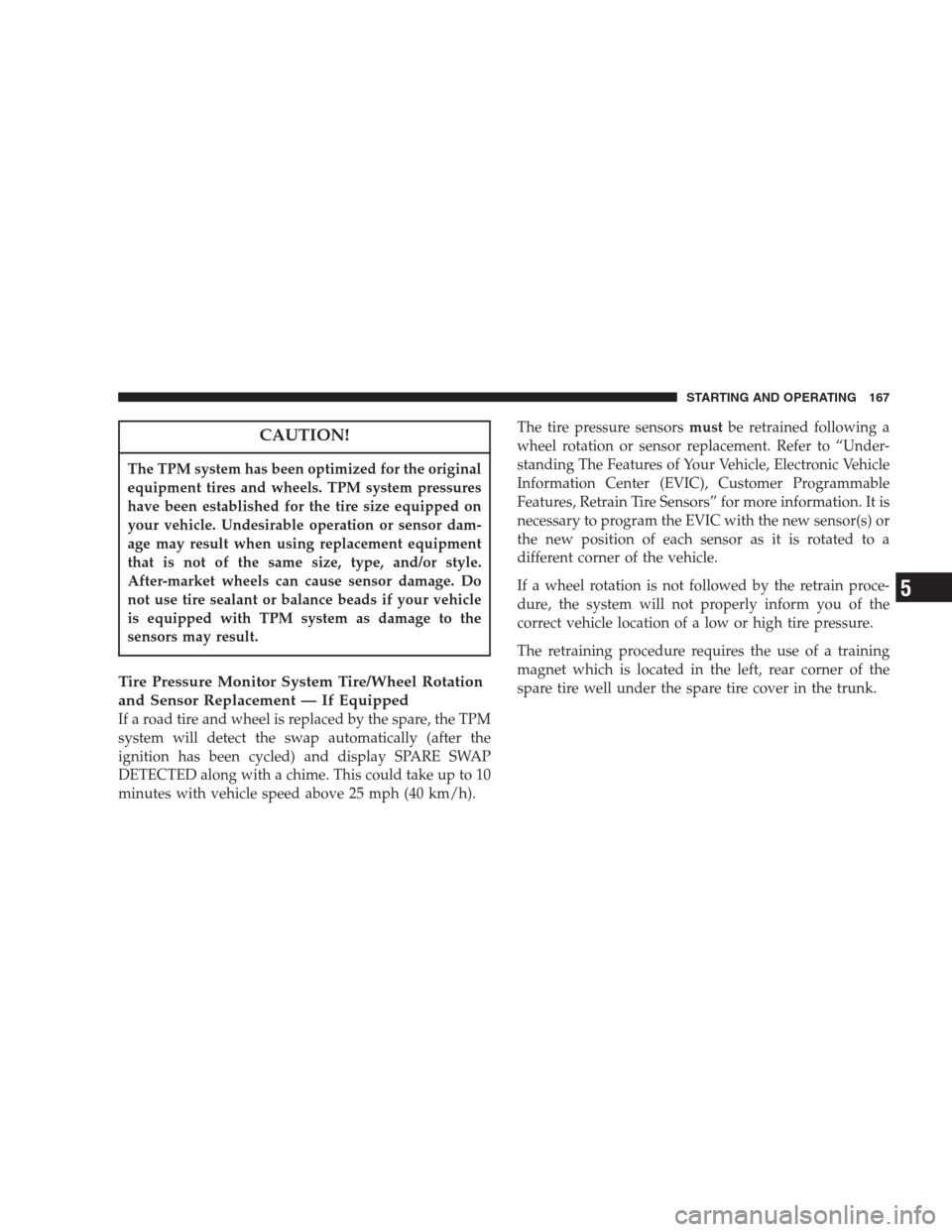
CAUTION!
The TPM system has been optimized for the original
equipment tires and wheels. TPM system pressures
have been established for the tire size equipped on
your vehicle. Undesirable operation or sensor dam-
age may result when using replacement equipment
that is not of the same size, type, and/or style.
After-market wheels can cause sensor damage. Do
not use tire sealant or balance beads if your vehicle
is equipped with TPM system as damage to the
sensors may result.
Tire Pressure Monitor System Tire/Wheel Rotation
and Sensor Replacement — If Equipped
If a road tire and wheel is replaced by the spare, the TPM
system will detect the swap automatically (after the
ignition has been cycled) and display SPARE SWAP
DETECTED along with a chime. This could take up to 10
minutes with vehicle speed above 25 mph (40 km/h).The tire pressure sensorsmustbe retrained following a
wheel rotation or sensor replacement. Refer to “Under-
standing The Features of Your Vehicle, Electronic Vehicle
Information Center (EVIC), Customer Programmable
Features, Retrain Tire Sensors” for more information. It is
necessary to program the EVIC with the new sensor(s) or
the new position of each sensor as it is rotated to a
different corner of the vehicle.
If a wheel rotation is not followed by the retrain proce-
dure, the system will not properly inform you of the
correct vehicle location of a low or high tire pressure.
The retraining procedure requires the use of a training
magnet which is located in the left, rear corner of the
spare tire well under the spare tire cover in the trunk.
STARTING AND OPERATING 167
5
Page 169 of 277
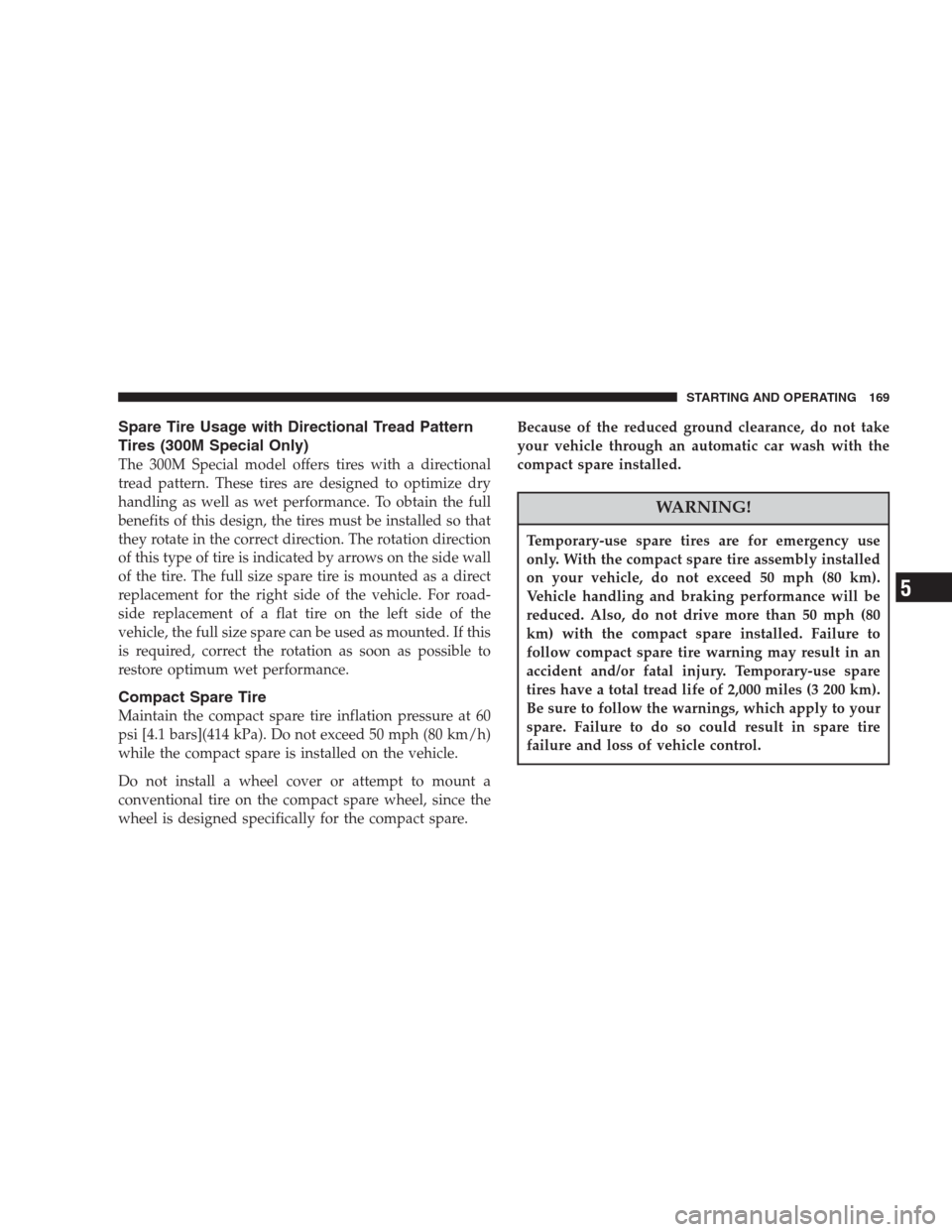
Spare Tire Usage with Directional Tread Pattern
Tires (300M Special Only)
The 300M Special model offers tires with a directional
tread pattern. These tires are designed to optimize dry
handling as well as wet performance. To obtain the full
benefits of this design, the tires must be installed so that
they rotate in the correct direction. The rotation direction
of this type of tire is indicated by arrows on the side wall
of the tire. The full size spare tire is mounted as a direct
replacement for the right side of the vehicle. For road-
side replacement of a flat tire on the left side of the
vehicle, the full size spare can be used as mounted. If this
is required, correct the rotation as soon as possible to
restore optimum wet performance.
Compact Spare Tire
Maintain the compact spare tire inflation pressure at 60
psi [4.1 bars](414 kPa). Do not exceed 50 mph (80 km/h)
while the compact spare is installed on the vehicle.
Do not install a wheel cover or attempt to mount a
conventional tire on the compact spare wheel, since the
wheel is designed specifically for the compact spare.Because of the reduced ground clearance, do not take
your vehicle through an automatic car wash with the
compact spare installed.
WARNING!
Temporary-use spare tires are for emergency use
only. With the compact spare tire assembly installed
on your vehicle, do not exceed 50 mph (80 km).
Vehicle handling and braking performance will be
reduced. Also, do not drive more than 50 mph (80
km) with the compact spare installed. Failure to
follow compact spare tire warning may result in an
accident and/or fatal injury. Temporary-use spare
tires have a total tread life of 2,000 miles (3 200 km).
Be sure to follow the warnings, which apply to your
spare. Failure to do so could result in spare tire
failure and loss of vehicle control.
STARTING AND OPERATING 169
5
Page 171 of 277
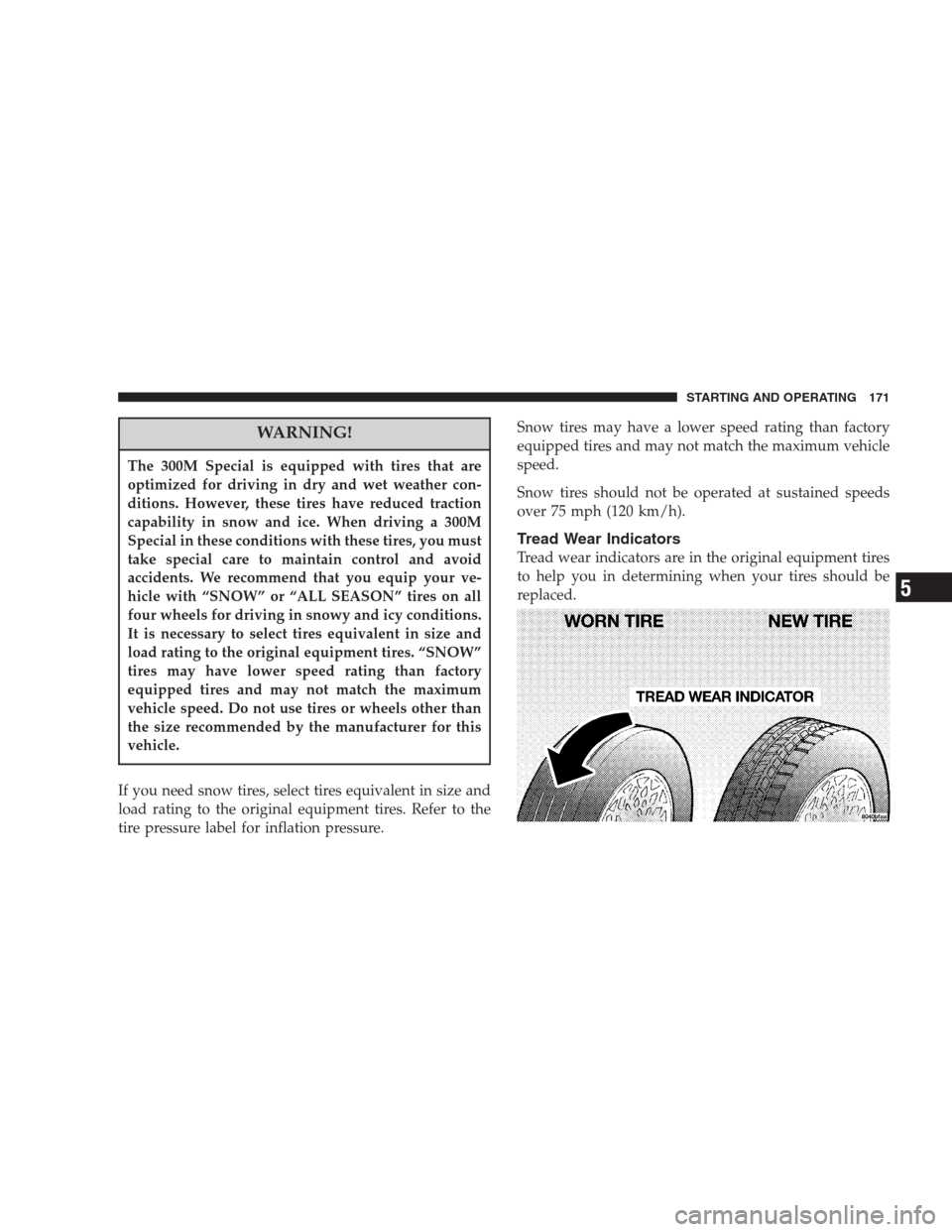
WARNING!
The 300M Special is equipped with tires that are
optimized for driving in dry and wet weather con-
ditions. However, these tires have reduced traction
capability in snow and ice. When driving a 300M
Special in these conditions with these tires, you must
take special care to maintain control and avoid
accidents. We recommend that you equip your ve-
hicle with “SNOW” or “ALL SEASON” tires on all
four wheels for driving in snowy and icy conditions.
It is necessary to select tires equivalent in size and
load rating to the original equipment tires. “SNOW”
tires may have lower speed rating than factory
equipped tires and may not match the maximum
vehicle speed. Do not use tires or wheels other than
the size recommended by the manufacturer for this
vehicle.
If you need snow tires, select tires equivalent in size and
load rating to the original equipment tires. Refer to the
tire pressure label for inflation pressure.Snow tires may have a lower speed rating than factory
equipped tires and may not match the maximum vehicle
speed.
Snow tires should not be operated at sustained speeds
over 75 mph (120 km/h).
Tread Wear Indicators
Tread wear indicators are in the original equipment tires
to help you in determining when your tires should be
replaced.
STARTING AND OPERATING 171
5
Page 172 of 277
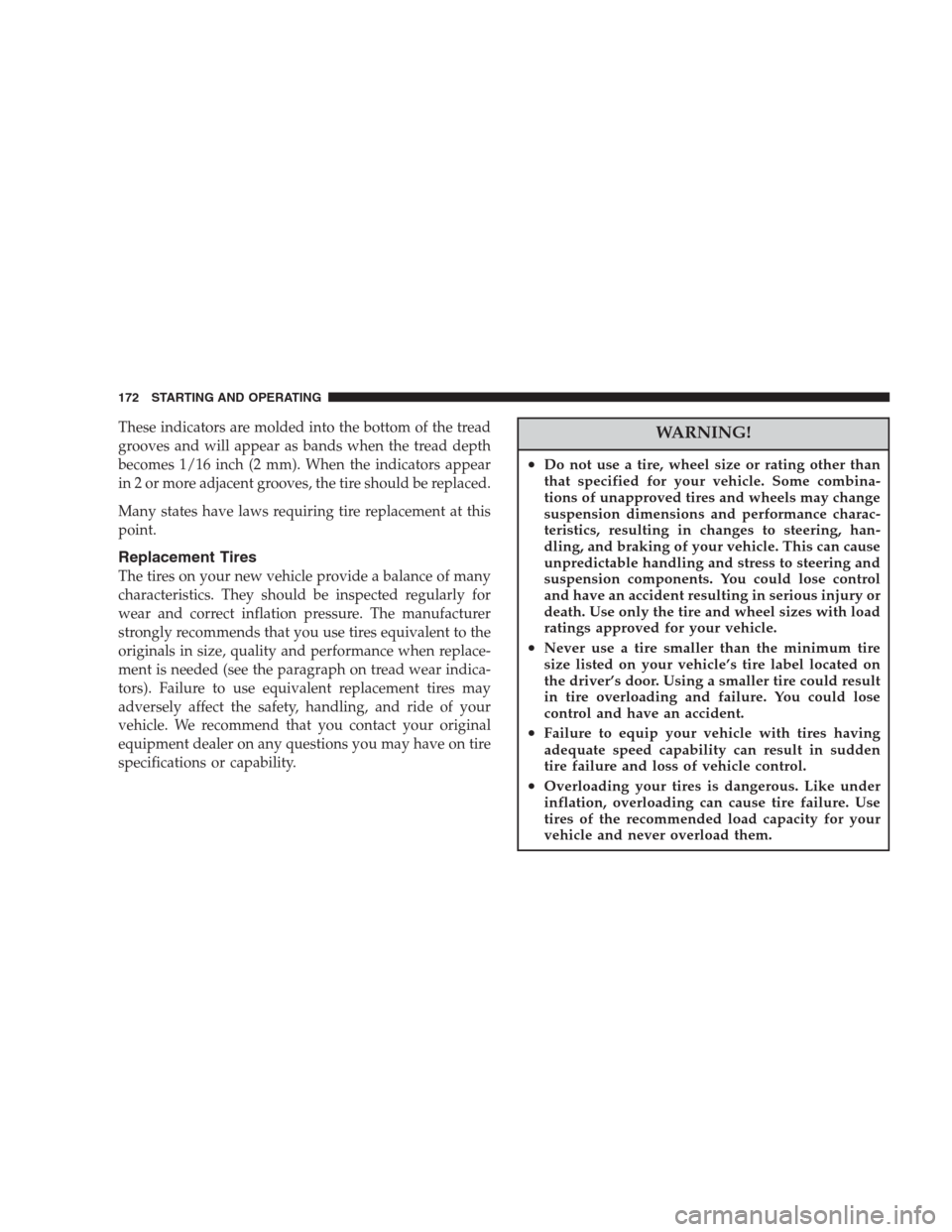
These indicators are molded into the bottom of the tread
grooves and will appear as bands when the tread depth
becomes 1/16 inch (2 mm). When the indicators appear
in 2 or more adjacent grooves, the tire should be replaced.
Many states have laws requiring tire replacement at this
point.
Replacement Tires
The tires on your new vehicle provide a balance of many
characteristics. They should be inspected regularly for
wear and correct inflation pressure. The manufacturer
strongly recommends that you use tires equivalent to the
originals in size, quality and performance when replace-
ment is needed (see the paragraph on tread wear indica-
tors). Failure to use equivalent replacement tires may
adversely affect the safety, handling, and ride of your
vehicle. We recommend that you contact your original
equipment dealer on any questions you may have on tire
specifications or capability.
WARNING!
•Do not use a tire, wheel size or rating other than
that specified for your vehicle. Some combina-
tions of unapproved tires and wheels may change
suspension dimensions and performance charac-
teristics, resulting in changes to steering, han-
dling, and braking of your vehicle. This can cause
unpredictable handling and stress to steering and
suspension components. You could lose control
and have an accident resulting in serious injury or
death. Use only the tire and wheel sizes with load
ratings approved for your vehicle.
•Never use a tire smaller than the minimum tire
size listed on your vehicle’s tire label located on
the driver’s door. Using a smaller tire could result
in tire overloading and failure. You could lose
control and have an accident.
•Failure to equip your vehicle with tires having
adequate speed capability can result in sudden
tire failure and loss of vehicle control.
•Overloading your tires is dangerous. Like under
inflation, overloading can cause tire failure. Use
tires of the recommended load capacity for your
vehicle and never overload them.
172 STARTING AND OPERATING
Page 173 of 277
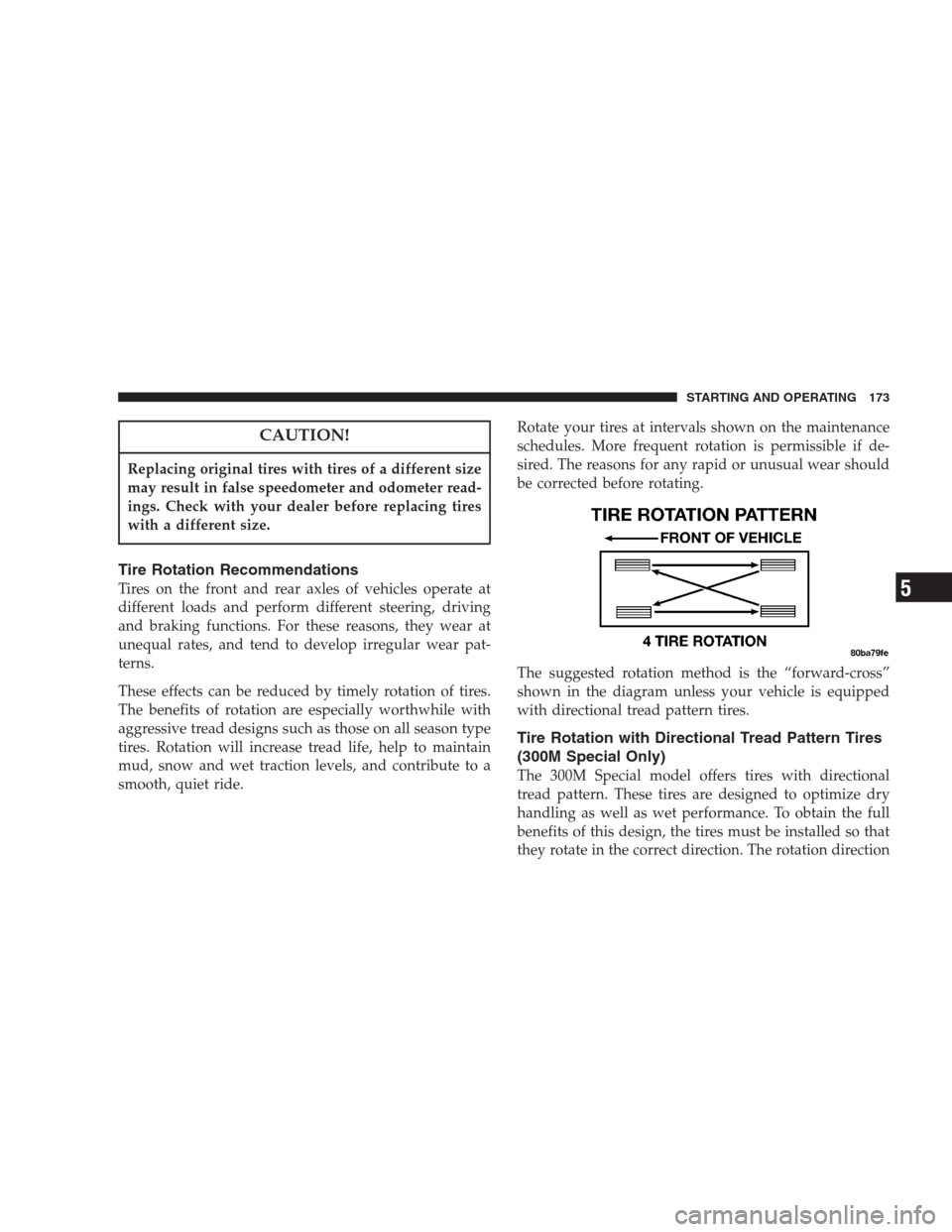
CAUTION!
Replacing original tires with tires of a different size
may result in false speedometer and odometer read-
ings. Check with your dealer before replacing tires
with a different size.
Tire Rotation Recommendations
Tires on the front and rear axles of vehicles operate at
different loads and perform different steering, driving
and braking functions. For these reasons, they wear at
unequal rates, and tend to develop irregular wear pat-
terns.
These effects can be reduced by timely rotation of tires.
The benefits of rotation are especially worthwhile with
aggressive tread designs such as those on all season type
tires. Rotation will increase tread life, help to maintain
mud, snow and wet traction levels, and contribute to a
smooth, quiet ride.Rotate your tires at intervals shown on the maintenance
schedules. More frequent rotation is permissible if de-
sired. The reasons for any rapid or unusual wear should
be corrected before rotating.
The suggested rotation method is the “forward-cross”
shown in the diagram unless your vehicle is equipped
with directional tread pattern tires.
Tire Rotation with Directional Tread Pattern Tires
(300M Special Only)
The 300M Special model offers tires with directional
tread pattern. These tires are designed to optimize dry
handling as well as wet performance. To obtain the full
benefits of this design, the tires must be installed so that
they rotate in the correct direction. The rotation direction
STARTING AND OPERATING 173
5